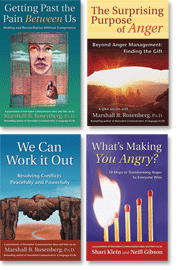 |
||||
 |
Feel a Fight Coming On? Clues to Transform Anger By Wayland Myers, Ph.D. |
|
|
The most common emotion I've seen couples struggle with is anger. This is what often happens: Someone gets angry (usually because they are hurting or afraid). The couple comes together to try to resolve the anger. So far so good. But then the trouble starts -- their dialogue is filled with ways of speaking and thinking that tend to make matters worse, like blaming, shaming, accusation, criticism, name-calling, defensiveness, and even silence. Keep reading this article >> |
 |
Mediating Between Warring Tribes By Marshall Rosenberg, Ph.D. |
|
| I once was asked to help mediate a conflict between two tribes in northern Nigeria -- between Christian chiefs and Muslim chiefs. These tribes had a lot of violence going on between them because of a conflict over how many locations in the marketplace each tribe would have to display its wares. One hundred of the four hundred people in this community had been killed the year I arrived. Keep reading this article >> |
|
|
||
|
|
|
|
||
|
Free Weekly Tips Series: •••Living Compassion Tips
PDF Downloads: |
|
|
||
|
"When we hear the other person's feelings and needs, we recognize our common humanity." Marshall Rosenberg, Ph.D.
|
|
|
Mediating Between Warring Tribes, continued
A colleague of mine who lives in Nigeria, seeing all this violence, worked very hard to meet the chiefs on both sides and get them to agree to meet and see if we could resolve this conflict. It took him six months, but he finally was successful, and that’s how I came to be working with the chiefs of these tribes.
As we were walking into the session, my colleague whispered to me, “Be prepared for some tension, Marshall.
Three of the people who are going to be in the meeting know that someone who killed their child is in the room.”
Well, it was very tense at first. There had been so much violence between these two groups, and this was the first time they had sat down together. Now there were twelve chiefs on one side of the table, twelve on the other. I started as I usually do in mediation. I said, “I’m confident that if anybody’s needs get expressed and understood, we’ll find a way to get everybody’s needs met. So who would like to begin, please? I’d like to hear what needs of yours are not being met.”
Unfortunately, they didn’t know how to express needs. They only knew how to express criticism and judgments. Instead of responding to my question, a chief from the Christian tribe yelled loudly and angrily across the table at the Muslims, “You people are murderers!”
(Notice I did not say, “What do you think of the other side?”)
So I asked, “What needs of yours are not getting met?”
Right away, there was the enemy image. Then, immediately, the other side came back: “You’ve been trying to dominate us.” There’s another diagnosis. With those kinds of enemy images, I could see why thirty percent of the population had been killed over the question of how many places in the marketplace each side will get.
They were screaming at each other, and it wasn’t easy to restore order. But our training shows that all criticisms, judgments, and enemy images are tragic, even suicidal, expressions of unmet needs. So in the world of mediation I loan them my Nonviolent Communication skills by translating their enemy image into a need. With the gentleman who said, “You’re murderers,” it wasn’t too hard.
I asked, “Chief, are you expressing a need for safety that isn’t being met? You have a need for safety. You would hope that no matter what’s going on, things could be resolved with nonviolence, correct?”
He said, “That’s exactly what I’m saying.”
Well, that wasn’t quite what he was saying. He said, “You’re murderers.” But it’s closer to the truth to hear the needs than the enemy image. With Nonviolent Communication skills, I was able to hear the needs behind the judgment.
But that wasn’t enough. I had to be sure his needs were heard by the other side. So I asked if a member of the other tribe would be willing to repeat what the chief from the first tribe had said. I looked over across the table to the Muslim chiefs and said, “Would somebody from this side of the table please tell me back what the chief said his needs were?”
And one of them screams over, “Why did you kill my son?”
And I said to the chief from the second side, “Chief, we’ll deal with that issue soon. For the moment, would you be willing to tell me what the first chief ’s feelings and needs are?”
Well, of course, he couldn’t do it. He was so involved in making judgments of the other side that he wasn’t able to hear the feelings and needs that I had helped articulate.
So I said to this chief, “Chief, what I hear the other chief feeling is anger, strong anger, because he says he has a need for conflicts, whatever they are, to be resolved in some way -- other than with violence -- so everybody can be safe.
Could you just say that back, Chief, so I’m sure we’re communicating?”
He wasn’t able to do it yet. I had to repeat the message at least two more times before he heard what the other chief was feeling and needing. Finally, he was able to tell me.
Then I helped the other chiefs express their needs. I asked, “Now that you hear what the needs are of the other side, I’d like you to tell me your needs.”
And one of the chiefs repeated the judgment he had made earlier by saying, “They have been trying to dominate us for a long time, and we’re not going to put up with it anymore.”
Once again I translated this judgment of the wrongness of the other side into the needs I sensed to be at the root of this judgment by asking, “Are you upset because you have a strong need for equality in this community?”
He said, “Yes.”
I turned to a member of the other tribe and said, “Could you repeat that so I’m sure that we’re communicating?”
They were not able to at first. I had to repeat that at least another two times before they were able to see that the other side had anger related to a need for equality that wasn’t being met.
All took about an hour just to get each side clear about their needs and to get the other side to hear them, because there was a lot of yelling and on in between. However, at that point, when I got both sides just to hear one need from each other, one of the chiefs jumped up to his feet and said to me, “Marshall, we can’t learn this in one day. And if we know how to talk to each other this way, we don’t have to kill each other.”
You see? He understood in one hour or so that if we can just say what our needs are without putting it in an enemy image, we can resolve conflicts peacefully.
And I said, “Chief, I’m glad you could see that so quickly. We were going to suggest at the end of the day that we would be glad to train people from both tribes to use this in case other conflicts come up. However, today I’m here to mediate the conflicts; I wasn’t here to teach you. And yes, you’re right. It can’t be learned in one day.”
He said, “I want to be one of those trained to do this.”
Several others in the room also were eager to volunteer to get the training. They could see that you don’t need weapons to resolve conflicts when you know how to connect clearly with each other’s needs.
Marshall B. Rosenberg, Ph.D. is the author of Nonviolent Communication: A Language of Life, Speak Peace in a World of Conflict, Life-Enriching Education, and dozens of booklets, videos and audiotape series. He is the founder and educational director of the Center for Nonviolent Communication, and spends over 200 days each year teaching NVC throughout the world.
Keep learning these vital communication skills with these books and training resources:
- Living Compassion Weekly Tips Series - Complimentary
- NVC Conflict Resolution Book Package - Save 50% through December 31, 2008

"If we can just say
our needs without putting
it in an enemy image,
we can resolve conflicts peacefully."
- Marshall Rosenberg, Ph.D.
"It’s closer to the truth
to hear needs than
the enemy image."
- Marshall Rosenberg, Ph.D.

